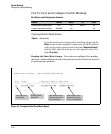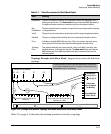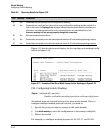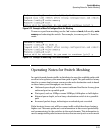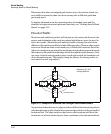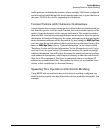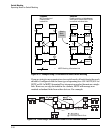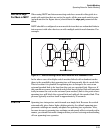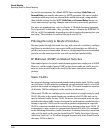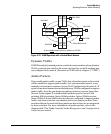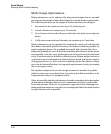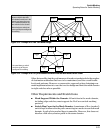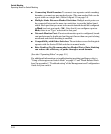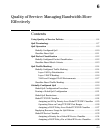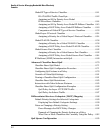
Switch Meshing
Operating Notes for Switch Meshing
In a mesh environment, the default MSTP timer settings (Hello Time and
Forward Delay) are usually adequate for MSTP operation. Because a packet
crossing a mesh may traverse several links within the mesh, using smaller-
than-default settings for the MSTP Hello Time and Forward Delay timers can
cause unnecessary topology changes and end-node connectivity problems.
For more on spanning-tree, refer to chapter 4, “Multiple Instance Spanning-
Tree Operation” in this guide. Also, you may want to examine the IEEE 802.1d,
802.1w, or 802.1s standards, depending on which version of spanning-tree you
are using. The switches covered in this guide use 802.1s.
Filtering/Security in Meshed Switches
Because paths through the mesh can vary with network conditions, configur-
ing filters on meshed ports can create traffic problems that are difficult to
predict, and is not recommended. However, configuring filters on nonmeshed
ports in an edge switch provides you with control and predictability.
IP Multicast (IGMP) in Meshed Switches
Like trunked ports, the switch mesh domain appears as a single port to IGMP.
However, unlike trunked ports, IGMP protocol and multicast traffic may be
sent out over several links in the mesh in the same manner as broadcast
packets.
Static VLANs
In a network having a switch mesh domain and multiple static VLANs config-
ured, all static VLANs must be configured on each meshed switch, even if no
ports on the switch are assigned to any VLAN. (The switch mesh is a member
of all static VLANs configured on the switches in the mesh.)
When static VLANs are configured, the mesh is seen as a single entity by each
VLAN. All ports in the mesh domain are members of all VLANs and can be
used to forward traffic for any VLAN. However, the non-mesh ports on edge
switches that allow traffic to move between the mesh and non-meshed devices
belong to specific VLANs and do not allow packets originating in a specific
VLAN to enter non-meshed devices that do not belong to that same VLAN. (It
is necessary to use a router to communicate between VLANs.) For example,
in the following illustration, traffic from host A entering the switch mesh can
only exit the mesh at the port for hosts B and E. Traffic from host A for any
other host (such as C or D) will be dropped because only hosts B and E are in
the same VLAN as host A.
5-20



